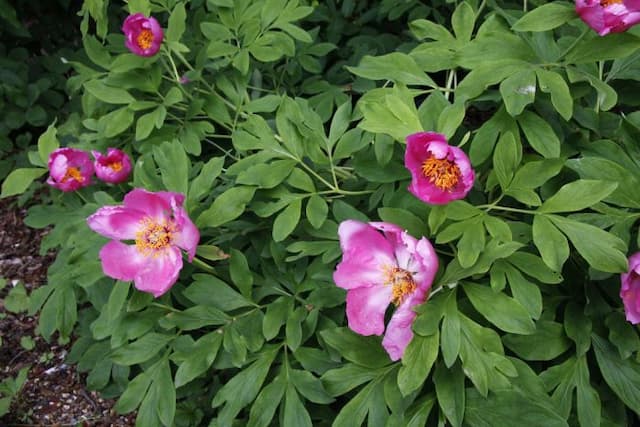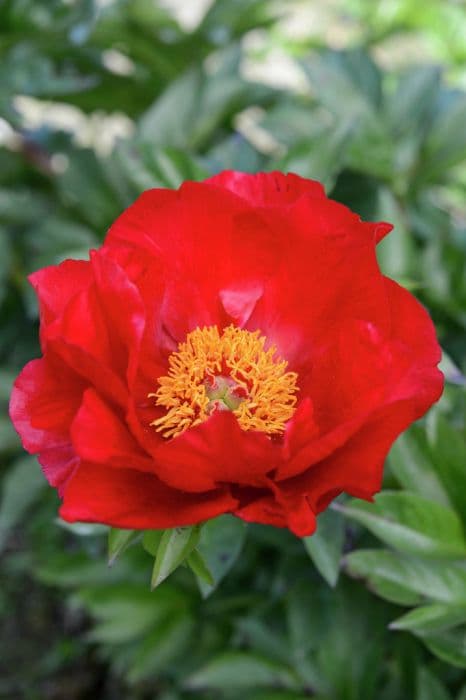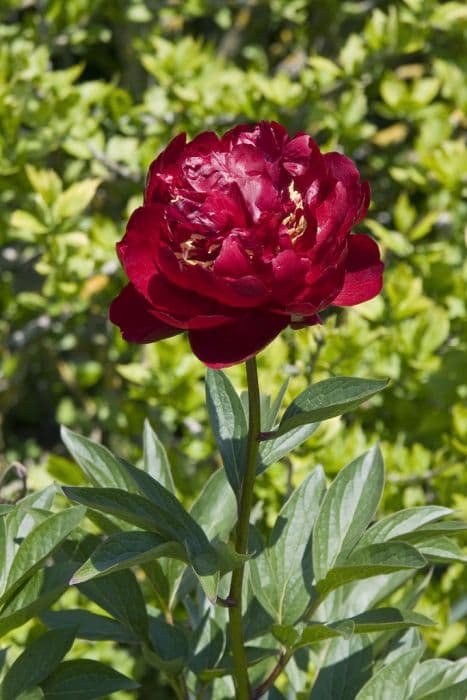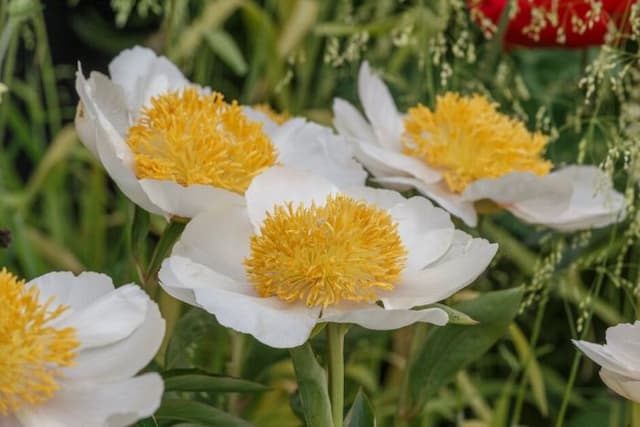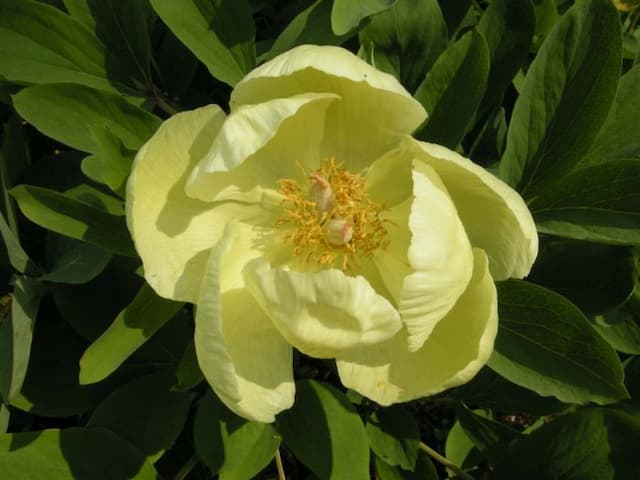Chinese peony Paeonia lactiflora 'Gardenia'

ABOUT
The Paeonia lactiflora 'Gardenia' is often referred to as the peony 'Gardenia'. This plant is famed for its lush, full blooms that closely resemble those of the gardenia flower. The flowers are a creamy white, imbued with a soft, appealing hue, which can sometimes feature a slight hint of pink at their heart as they mature. These flowers are highly fragrant and boast a large, double form, with layer upon layer of ruffled petals that create a very rounded, full appearance. The peony 'Gardenia' has a very classic and sophisticated look, with its opulent flowers standing out against the deep green foliage. The leaves are glossy and make for an attractive backdrop; they have a broad, lance-shaped form and are neatly arranged on sturdy stems that gracefully support the heavy blooms. As a perennial, this plant has a cycle of growth, blooming, and dormancy throughout the year, and when in bloom, it serves as a striking focal point in any garden due to its lush and romantic flowers.
About this plant
 Names
NamesFamily
Paeoniaceae
Synonyms
Chinese Peony, White Peony, Common Garden Peony
Common names
Paeonia lactiflora, Paeonia albiflora, Paeonia edulis.
 Toxicity
ToxicityTo humans
The common peony (Paeonia lactiflora 'Gardenia') is generally considered non-toxic to humans. However, peonies contain a compound called paeonol which can cause mild gastrointestinal upset if ingested in large quantities. Symptoms of peony ingestion may include nausea, vomiting, or diarrhea. It is important to keep in mind that the roots are more likely to contain higher concentrations of potentially irritating substances, so caution should be taken when handling or ingesting this part of the plant.
To pets
Common peony (Paeonia lactiflora 'Gardenia') is considered to be only mildly toxic to pets such as cats and dogs. If a pet ingests parts of a peony plant, they may experience mild vomiting or diarrhea. The toxic components are more concentrated in the roots and seeds, so these parts should be kept out of reach of pets. In general, peony ingestion does not cause severe poisoning or long-term health problems, but if a pet consumes a large amount of the plant and shows signs of distress, it is advised to consult a veterinarian.
 Characteristics
CharacteristicsLife cycle
Perennials
Foliage type
Deciduous
Color of leaves
Green
Flower color
White
Height
2-3 feet (60-90 cm)
Spread
2-3 feet (60-90 cm)
Plant type
Herbaceous
Hardiness zones
3-8
Native area
Asia
Benefits
 General Benefits
General Benefits- Aesthetic Appeal: Paeonia lactiflora 'Gardenia', commonly known as Chinese Peony 'Gardenia', showcases beautiful double white flowers with a hint of yellow at the base, giving gardens an elegant and sophisticated look.
- Garden Focal Point: With its stunning blooms and lush foliage, Chinese Peony 'Gardenia' often serves as a centerpiece in garden designs, drawing the eye and adding interest.
- Seasonal Interest: The plant blooms in late spring to early summer, providing a burst of color when many spring bulbs have finished flowering.
- Attracts Pollinators: The flowers of the Chinese Peony 'Gardenia' attract bees and other pollinators, helping to support local ecosystems and pollinate other plants in the garden.
- Longevity: Chinese Peony 'Gardenia' is a long-lived perennial plant, which means it can thrive in the garden for many years with proper care.
- Cut Flower Garden Potential: The large, full blooms are ideal for cutting and creating fragrant, stunning bouquets for indoor enjoyment.
- Cold Hardiness: As a hardy perennial, the Chinese Peony 'Gardenia' can survive cold winters, making it suitable for gardens in many temperate regions.
- Low Maintenance: Once established, this peony requires minimal care, making it a good choice for gardeners of all skill levels.
- Resists Deer and Rabbits: The plant is somewhat resistant to browsing by deer and rabbits, which helps to reduce damage and the need for protective measures in the garden.
 Medical Properties
Medical Properties- Anti-inflammatory: Components in Paeonia lactiflora may have properties that reduce inflammation.
- Immune system modulation: Some studies suggest that extracts from the root of the plant can modulate the immune system.
- Antispasmodic: The plant has been traditionally used to ease muscle spasms.
- Anxiolytic: There is evidence to suggest that Paeonia lactiflora may have a calming effect and reduce anxiety.
- Antioxidant: The root contains compounds that may act as antioxidants, neutralizing free radicals in the body.
- Cardiovascular health: Compounds in Paeonia lactiflora may have a beneficial effect on cardiovascular health, although the exact effects are not fully established.
 Air-purifying Qualities
Air-purifying QualitiesThis plant is not specifically known for air purifying qualities.
 Other Uses
Other Uses- Cut Flowers: The Paeonia lactiflora 'Gardenia', commonly known as the peony, has large, fragrant blooms that are highly prized for cut flower arrangements and can last more than a week in a vase if cared for properly.
- Wedding Decor: Peonies are a popular choice for bridal bouquets and wedding centerpieces due to their lush appearance and sweet scent.
- Photography Subjects: The attractive blooms of peonies make them excellent subjects for photography, often used in floral and garden photography to capture their intricate petals and color.
- Drying and Pressing: Peony petals can be dried or pressed for use in crafts, such as creating floral bookmarks, art pieces, and greeting cards.
- Garden Themes: Peonies can be used to create a themed garden area, such as a "white garden" or a "cottage garden," with their traditional appeal and romantic feel.
- Natural Fabric Dyes: The petals of the peony can be used to produce natural dyes for fabrics, offering hues from light pink to deeper shades depending on the concentration.
- Edible Garnish: Some peony petals are edible (although it's important to ensure no pesticides have been used) and can be used as a decorative and subtly flavored garnish for salads and desserts.
- Perfumery: The scent of peonies is often replicated in perfumes and scented products, and the petals can be infused into oils to make natural, floral-scented body care products.
- Artistic Inspiration: The peony often serves as inspiration for artists and is featured in paintings, textiles, and decorative motifs, symbolizing beauty, romance, and prosperity.
- Cultural Events: In some cultures, peonies are used during certain festivals or events, representing good luck and happiness, and are incorporated into the decor for such occasions.
Interesting Facts
 Feng Shui
Feng ShuiPeony is often associated with wealth and honor in Feng Shui. To enhance romantic luck, it can be placed in the southwest corner of a garden or home. However, it should not be placed in the bedroom as it could lead to affairs.
 Zodiac Sign Compitability
Zodiac Sign CompitabilityThe peony is not used in astrology practice.
 Plant Symbolism
Plant Symbolism- Prosperity: Peonies have been associated with wealth and honor in various cultures, often related to their full, round blossoms.
- Romance: The lush and fragrant flowers of peonies make them a symbol of romantic love and often used in wedding bouquets and decorations.
- Good Fortune: In China, peonies are considered a symbol of good luck and high status, and are often given as gifts to convey best wishes.
- Beauty: With their large, showy petals, peonies embody the ideal of feminine beauty in many cultural traditions.
- Happiness: The peony's vibrant and bountiful blooms bring to mind feelings of joy and are often associated with a happy life or marriage.
- Healing: Historically, peonies have been used for their medicinal properties, symbolizing healing and good health.
- Nobility: In ancient and medieval times, peonies were often associated with royalty and nobility, due to their opulent appearance and presence in imperial gardens.
 Water
WaterThe common name for Paeonia lactiflora 'Gardenia' is the Chinese Peony 'Gardenia'. Water your Chinese Peony 'Gardenia' deeply once a week, ensuring that the soil is moist but not waterlogged. During the growing season, if you receive less than an inch of rainfall per week, supplement with additional water. It's best to supply the equivalent of 1 gallon of water for each plant weekly. Adjust watering for your peony during particularly hot or dry periods, providing additional water to maintain soil moisture.
 Light
LightThe Chinese Peony 'Gardenia' thrives best in a sunny spot with at least six hours of direct sunlight daily. However, it tolerates partial shade, especially in hotter climates where some relief from the intense afternoon sun can be beneficial. Avoid deep shade conditions as they can hinder bloom production and overall health.
 Temperature
TemperatureChinese Peonies 'Gardenia' are cold hardy and can tolerate winter temperatures as low as -20 degrees Fahrenheit, but they grow best when summer temperatures range from 65 to 75 degrees Fahrenheit. They can survive short periods of higher temperatures up to 85 degrees Fahrenheit but may require additional care like mulching and shading in these conditions.
 Pruning
PruningPrune your Chinese Peony 'Gardenia' primarily to remove spent blooms after flowering and to cut back foliage in the fall after it has died back naturally. This helps prevent disease and prepares the plant for winter. The best time for pruning is post-flowering in summer and when preparing the plant for dormancy in late autumn.
 Cleaning
CleaningAs needed
 Soil
SoilThe best soil mix for Peony 'Gardenia' is well-drained, fertile loam with plenty of organic matter. Aim for a soil pH of 6.5-7.0. Amend soil with compost before planting for optimal growth.
 Repotting
RepottingPeony 'Gardenia' does not require frequent repotting as it is typically grown in the garden. However, if grown in containers, repot every 3-4 years in spring before new growth starts.
 Humidity & Misting
Humidity & MistingPeony 'Gardenia' is tolerant of a wide range of humidity levels and prefers a garden environment. Ideal humidity conditions mimic those outdoors, without the need for specific humidity adjustments.
 Suitable locations
Suitable locationsIndoor
Grow Peony 'Gardenia' indoors with bright indirect light and cool temperatures.
Outdoor
Plant Peony 'Gardenia' in a sunny spot with well-draining soil.
Hardiness zone
3-8 USDA
 Life cycle
Life cycleThe life cycle of Paeonia lactiflora 'Gardenia', commonly known as the Gardenia Peony, begins with seed germination, which occurs in late winter to early spring if the seeds have undergone a period of cold stratification. Upon sprouting, the seedling establishes a root system and a single shoot that will develop into a stem with leaves. The plant enters a vegetative state, where it focuses on growing leaves and roots until it has matured enough to support flowers, typically taking several years. Once mature, the peony enters the blooming stage in late spring to early summer, producing large, fragrant white flowers. After pollination, if it occurs, the flowers develop into seed pods that mature by late summer and eventually disperse seeds. At the onset of autumn, the peony's foliage dies back, and the plant enters a period of dormancy through the winter, allowing it to conserve energy for the next growth cycle.
 Propogation
PropogationPropogation time
Early spring
The common peony, specifically the Paeonia lactiflora 'Gardenia', is most effectively propagated by division, which is best done in the fall after the plants have become dormant. When dividing a peony plant, gardeners should use a sharp spade or knife to gently separate the root ball into sections, each with at least three to five well-developed eyes, which are the growth nodes. These sections should then be replanted immediately at a depth where the eyes are around 1.5 to 2 inches (about 4 to 5 centimeters) beneath the soil surface, to ensure proper development and blooming. Divisions should be spaced about 3 feet (approximately 91 centimeters) apart to give them ample room to grow. Watering the new divisions thoroughly after planting helps to establish them in their new location.
